BOSNIA AND HERZEGOVINA
History

History
Cities in BOSNIA AND HERZEGOVINA
| Sarajevo |
History
Antiquity and Middle Ages
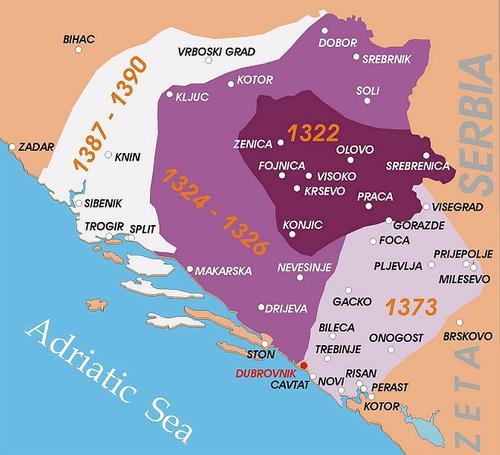
Archaeologists have found evidence that people lived in these regions as early as 200,000 years ago. These people lived in the Paleolithic era and were hunters and gatherers.
Bosnia and Herzegovina and the western Balkans were inhabited by the Illyrians, an Indo-European speaking people, in the centuries before the beginning of our era. This people was often attacked by Celts and Greeks at that time.
In 9 AD. the last great revolt of the Illyrians against the Romans was crushed and the present area was settled in the Roman provinces of Dalmatia and Pannonia. The Romans provided a period of reasonable stability, but that changed when the Roman Empire collapsed.
In the sixth century the first agricultural Slavs arrived in the Balkans, at about the same time as the Avar warrior people. The Avars were chased away, but followed by Serbs and Croats, probably from Poland and the Czech Republic. The Serbs settled in the southeast of the Balkans, the Croats in the western part, including much of what is now Bosnia-Herzegovina. These peoples mixed with the Slavs and were soon Christianized.
Bosnia was first mentioned in written sources in 958, and was at that time dominated by the Serbs. After the Serbs, Bosnia-Herzegovina was dominated by various peoples: first by Croats for a period and then by Bulgars for a short while. In the second half of the 12th century, authority in Bosnia and Herzegovina was disputed by the Byzantine Empire and Hungary.
In 1180, the first Bosnian monarch Ban Kulin declared independence from Hungary. Due to the increasing trade with Dubrovnik and Venice, prosperity in the area increased. After the death of Kulin, Bosnia and Herzegovina became a plaything of noble families, which led to the reign of Ban Stjepan Kotromanic in 1322. It was he who added the region of Herzegovina to Bosnia and under his rule it went very well in an economic sense, but also in terms of tranquility and peace.
The next ruler, Tvrtko I Kotromanic, expanded Bosnia with Croatia and large parts of the Dalmatian coast. He entered into a treaty with the Serbian ruler Lazar and subsequently crowned himself king of Bosnia and Serbia. After the death of Kotromanic in 1391 an unclear transition situation arose, which lasted until the arrival of the Turks.
Turkish rule
The Ottoman Turks soon conquered large parts of the Balkans, but it was not until 1463 that they brought Bosnia under their rule. In that time Islam also made its appearance in Bosnia and Herzegovina.
The Turks turned strategically located Bosnia-Herzegovina into a pure conquest and also demand that many ten-year-old boys in Istanbul be trained for the Turkish army (the so-called "devsirme")
From 1683, the once powerful Ottoman Empire slowly fell into decline. They suffered some major defeats against the Austrians and the siege of Vienna also failed completely. Only in 1878 the Turks were finally defeated, after an uprising that had already started in Bosnia-Herzegovina in 1875 and spread to Serbia and Montenegro. When the revolt threatened to be crushed, Russia intervened. The Austro-Hungarian Habsburgs allowed this interference, on the condition that only the eastern Balkans could fall within the Russian sphere of influence; Bosnia and Herzegovina would then join Austria. All of these battlegrounds created unprecedented migration flows that continue to cause problems in the Balkans to this day.
First World War

At the Congress of Berlin in 1878, Bosnia and Herzegovina was placed under Austrian rule, but the Muslim population was still loyal to the Turkish sultan. Meanwhile, the Serbs suffered greatly from the Habsburg rule. When Bosnia-Herzegovina was definitively annexed by Austria-Hungary in 1908, the South Slavic (Yugoslavian) population's aversion towards its rulers grew. In 1914, the Habsburg Crown Prince Frans Ferdinand was shot dead by the Serbian nationalist Gavrilo Princip, which later turned out to be the start of the First World War. Serbia declared war on the Netherlands, after which the conflict spread like an inkblot. Ultimately, 32 countries would participate in the war, including the United States, United Kingdom, France, Russia, and Germany. The Netherlands remained neutral.
At the end of World War I, the "Kingdom of Serbs, Croats and Slovenes" was established, but that cooperation did not last long. The Serbs wanted a centrally managed state, the Croats and Slovenes wanted a loose federal structure. Bosnia did not appear at all in this chapter and was considered by the Croats and the Serbs to be Greater Croatia and Greater Serbia respectively. In 1929 the Serbian king Alexander proclaimed the royal dictatorship and the young parliament is already exit. Its name was changed to "Kingdom of Yugoslavia" and the borders of Bosnia and Herzegovina are removed from this unitary state. In 1934 Alexander was murdered by Croatian nationalists.
WWII
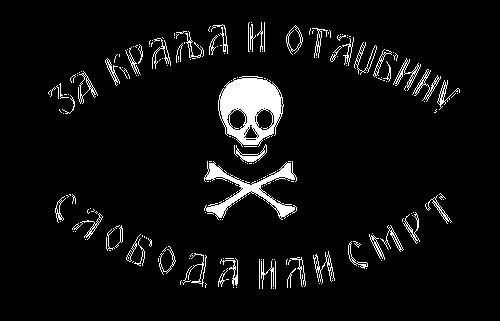 Flag of the Cetniks of Bosnia and HerzegovinaPhoto:Voytek s in the public domain
Flag of the Cetniks of Bosnia and HerzegovinaPhoto:Voytek s in the public domain
In April 1941, Yugoslavia surrendered to the Germans and Bosnia and Herzegovina was incorporated into the "Independent State of Croatia". This fascist Greater Croatia became a nightmare for the Roma, Jews and Serbs, who were murdered, deported or forced to convert to Catholicism. These atrocities were committed by the Croatian fascists or "Ustaša".
The resistance against the fascists was led by Serbian "Cetniks" and by the partisans (Serbs, Croats and Muslims) of the communist Soviet Union-oriented Josip Broz, better known as Tito. The fascists make many victims, but the resistance groups are also fighting a fierce battle for hegemony. Tito and his partisans eventually won the mutual battle, also because the Cetniks collaborated with the Germans. On April 6, 1945, Tito's partisans marched into Sarajevo and Yugoslavia was liberated.
Period Tito
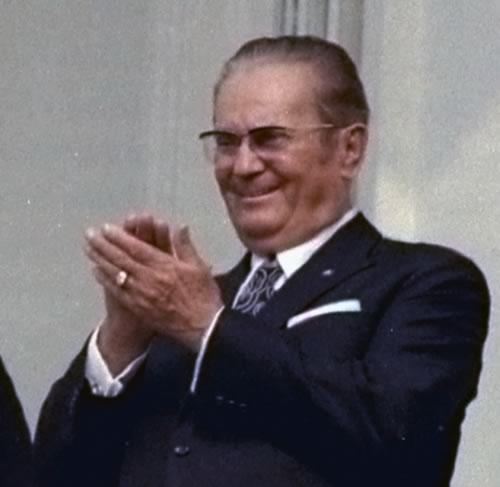
Tito automatically became the new political leader and dealt with bloody remnants of the Ustaca, Cetniks and Yugoslav royalists. In a relatively short time he managed to establish a socialist society in which "everyone" was equal and benefited from the rapidly increasing prosperity. Bosnia-Herzegovina was given the status of constituent republic within the federation of Yugoslavia and participated in the economic revival.
Yet after Tito's death in 1980 and the ensuing power vacuum, it quickly became clear that the Yugoslav "unity" was not at all well. In 1984 the 14th Winter Olympics were held in Sarajevo.
Yugoslavia is falling apart
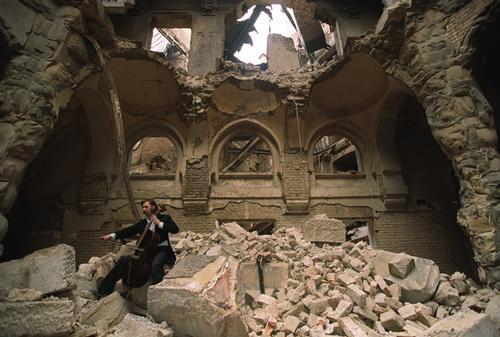
Due to the liberalization of Gorbachev in the Soviet Union and the fall of the wall in Berlin, nationalism also emerged in Yugoslavia and political parties with a strong nationalist slant were established in the various republics. In Bosnia and Herzegovina, these were Alija Izetbegovic's Islamic SDA (Democratic Action Party), Radovan Karadžic's SDS (Serbian Democratic Party), and Stjepan Kljuic's HDZ (Croatian Democratic Union), which was in fact directly controlled by Croatia. The November 1990 elections were a huge success (86% of the vote) for the nationalist Izetbegovic, who subsequently became president. In March 1991, consultations took place between Tudjman and Milosevic on a division of Bosnia and Herzegovina between Croatia and Serbia. Karadžic, the leader of the Bosnian Serbs, started this division and proclaimed parts of Bosnia and Herzegovina in the north and west as "Serbian Autonomous Areas". President Izetbegovic, meanwhile, anxiously tried to keep his country's borders together, also because he feared the fate of the Muslims.
In 1992 Slovenia and Croatia seceded from Yugoslavia after some fighting and were recognized as independent countries by the European Union on January 15, 1992. Bosnia-Herzegovina was then faced with the difficult choice of either extending independence or joining Milosevic's "Greater Serbia". Choosing independence undoubtedly meant choosing war with Milosevic. Despite calls for boycotts of the elections and intimidation practices, the population voted almost unanimously in favor of independence.
From the day the referendum results were announced, March 2, 1992, Bosnia and Herzegovina was heading straight for civil war, as expected. Serb paramilitaries soon took up positions in Sarajevo, and in late March, Karadzic unilaterally proclaimed the Bosnian Serb Republic ("Republika Srpska") in the Serb Autonomous Territories. In June, Mate Boban's nationalist Croats proclaimed the "Croatian Community of Herzeg-Bosna". Serb paramilitaries and Bosnian Serbs attacked Muslims in several cities, resulting in deaths. The Federal Yugoslav Army even bombed the city of Zvornik.
Despite the very tense situation, on April 6, 1992, the European Union recognized Bosnia and Herzegovina as an independent country. Despite the arms boycott of the United Nations, the Yugoslav army had so many weapons that approximately 70% of the Bosnian territory was quickly conquered.
The Muslims and Bosnian Croats initially fought side by side against the common enemy, but the Croats had a double agenda. A division of Bosnia-Herzegovina into a Greater Croatia would also bring them many benefits. Gradually their attitude towards Muslims changed and in early 1993 very violent armed conflicts arose between the Muslims and the Bosnian Croats. This infighting lasted until 1994; under pressure from the United States, the two fighting parties decided to work together again. Meanwhile, the historic city of Sarajevo was under constant attack by the Serbs, killing thousands of people. This would eventually lead to military intervention by NATO. In May and August 1995, the fighting turned when the Croats, with American support, managed to expel the Serbs from Croatia. At the same time, violence in the Krajina, the border region between Croatia and Bosnia, increased enormously. Many fled to Serbia and the Republic of Srpska, chased by the Bosnian army. The Americans feared huge flows of refugees and put pressure on the Bosnians to stop their advance. The fall of Srebrenica and the subsequent genocide of the Bosnian Serbs also brought the warring parties back to the negotiating table and on 21 November 1995 the Dayton peace agreement was concluded. Only then did it become clear what the consequences were of the battle: hundreds of thousands of deaths and injuries, and more than two million homeless people and refugees. The entire infrastructure had disappeared and basic items such as clean water, gas and electricity were almost impossible to obtain.
After the 1995 agreement, NATO brought peace to the area. The SFOR force finally created a fairly stable situation, and the United Nations provided an International Police Task Force (IPTF) to get the local police back on their feet. From 1996 onwards, the OSCE organized elections and the UNHCR, the UN Refugee Agency, was given the lead to ensure the return of the many refugees.
The current state is divided into part for the Serbs, the Republic of Srpska, and part for the Croats and the Bosniaks (Bosniak Muslims), the Federation of Bosnia and Herzegovina, the so-called entities.
Yet all citizens have the opportunity to live wherever they want. The weak central government is headed by a presidium of three people: a Bosnjak, a Croat and a Serb.
The two entities each have their own government, president, army and parliament. Furthermore, there is a separate district around the city of Brcko in the northeast, with self-government, but under the central presidium.
The parliamentary elections of September 14, 1996 were won by the Muslim-dominated Party for Democratic Action (SDA), which subsequently provided Alija Izetbegovic as president of the three-member presidium. In January 1997, the first federal Bosnian government was formed, with the dividing lines between the parties mainly running along ethnic lines.
In parliamentary elections in 1998, the three largest ethnic parties, the Serbian Democratic Party (SDS), the Croatian Democratic Community (HDZ) and the SDA were unable to maintain their majority in the central federation. The SDA then formed a coalition with parties that deviated from the ethnic principle in Bosnian politics and that supported the development of Bosnia-Herzegovina as a sovereign and democratic state.
Meanwhile, the country's economic situation hardly improved. Many young people and the better educated preferred to emigrate and many refugees did not return from abroad.
2000 to present
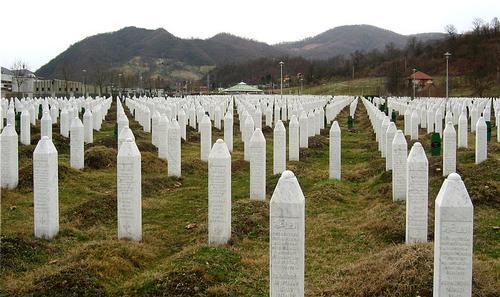
On June 21, the Security Council renewed the mandate of the SFOR peacekeeping force and the 1,600-man police force.
In March 2000, a 'donor conference' for the Balkans was held in Brussels, which failed to allay the concerns of the international world about developments in Bosnia and Herzegovina. Reforms were too slow for that to happen, there was still far too much bureaucracy and the country was ravaged by corruption and widespread smuggling. The EU High Representative, Wolfgang Petritsch, repeatedly stressed the need for state formation. After the elections in Croatia, January 2000, and the fall of Miloseviæ on October 5, the chances of the state formation desired by the European Union seemed to be approaching.
The International Criminal Tribunal for the former Yugoslavia made itself heard with convictions of Croatian General Blaskic and Bosnian Croats Kordic and Cerkez. The trial of General Radislav Krstic, held partly responsible for the mass murder of more than 7,000 Muslim men, was also opened.
In 2000 more than 20,000 refugees returned to Bosnia-Herzegovina, but due to the poor economic situation more than 300,000 refugees continued to live abroad for the time being. Important for the refugees was the ruling of the Constitutional Court that Serbs, Muslims and Croats had equal rights everywhere in Bosnia-Herzegovina. Until then, Serbs in Republika Srpska and the Muslims and Croats within the Federation each had separate status.
On June 22, 2000, parliament approved the new government of the non-party Prime Minister Spasoje Tusevljak, who saw the restoration of the deplorable economy as its main task. In April, divisions along ethnic lines in local elections again became apparent, and the parliamentary elections in November also confirmed this image of political support through ethnic lines. No party obtained an absolute majority. The OSCE punished various parties for violating electoral rules.
On October 14, Head of State Izetbegovic resigned, and his place in the three-member state presidency was taken by Halid Genjac of the Muslim PDA.
At an administrative level things did not go well in Bosnia and Herzegovina. At the beginning of 2001, the Croatian Ante Jelavic was expelled from the reigning triumvirate for alleged obstruction of the multi-ethnic government. Wolfgang Petritsch, the High Representative of the international community, warned the Bosnian Serbs to stop their obstruction against the federal state of Bosnia. Police authorities were often fired on charges of corruption.
Zlatko Lagumdzija was elected Prime Minister by the reigning triumvirate in July to replace Bozidar Matic who has resigned. The moderate Croat Jozo Krizanovic joined the triumvirate to replace Ante Jelavic.
In November, former President Milosevic of Yugoslavia was charged with committing genocide during the Bosnian War. Ex-president of the Serbian Republic Biljana Plavsic volunteered. In June, Muslim Fikret Abdic suspected of war crimes was arrested.
Bosnian Serb Stevan Todorovic was sentenced to ten years in prison, but three Bosnian Croats were acquitted on appeal of the murder of hundreds of Muslims near the village of Ahmici in 1993. Bosnian Serb general Radislav Krstic was eventually sentenced to 35 years in prison for his part in the genocide at the Muslim enclave Srebrenica. Three generals during the war, Hadzihasanovic, Alagic and Kubura, were transferred to The Hague.
The socio-economic situation hardly improved in 2001. More than 80% of the population was still living below the poverty line and corruption and smuggling were among the most important economic acts. The informal economy comprised 40 to 60% of all economic activity. The main railway line between Croatia and Bosnia was reopened in June.
More than 30,000 refugees returned to the Muslim-Croat Federation and 18,000 to the Serbian Republic.
The UN Security Council renewed the mandate for the international police mission in July 2002. The mission, consisting of more than 1,500 men, was tasked with training the multi-ethnic police.
On February 12, 2002, the trial against Slobodan Milosevic was opened in The Hague. A number of prominent individuals have been called to testify against the former President of Yugoslavia, including Paddy Ashdown and Ibrahim Rugova, President of Kosovo. Ex-president of the Republika Srpska Biljana Plavsic, however, refused to testify against Milosevic.
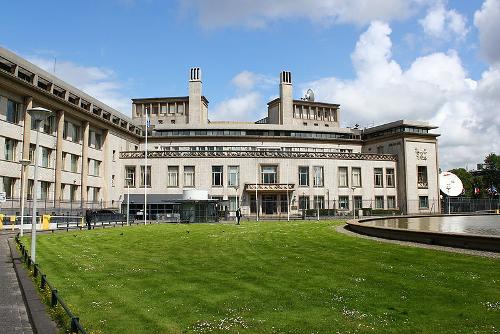 Bosnia and Herzegovina Yugoslavia Tribunal The HaguePhoto:Julian Nyca CC 4.0 International no changes made
Bosnia and Herzegovina Yugoslavia Tribunal The HaguePhoto:Julian Nyca CC 4.0 International no changes made
In May 2002, former Deputy Prime Minister of Yugoslavia, Nikolai Sainovic, who was suspected of war crimes, arrived in The Hague. In July 2002, a new mass grave was discovered near Zvornik with probably more than 100 Srebrenica victims.
Elections to the federal parliament were gloriously won by nationalist parties such as the Serbian SDS, the Croatian HDZ and the SDA of the Muslims. Voting was again clear along ethnic lines, which of course did not promote state formation.
On April 2, the chairman of the lead triumvirate in Bosnia and Herzegovina, Mirko Sarovic, resigned over possible involvement in illegal arms transfers to Iraq. The appointment of his successor, Borislav Paravac, confirmed the deteriorating relations between the ethnic groups.
In July, 282 victims of the 1995 Srebrenica massacre were reburied in Srebrenica. The remains of 5,000 victims had been recovered since 1995 and 1,620 bodies had been identified.
In November 2003, the President of Serbia and Montenegro, Svetozar Marovic, visited the Bosnian capital Sarajevo. He publicly apologized for crimes committed by Serbs in the war in Bosnia (1992-1995). The visit was part of efforts to improve relations between the two countries.
In October, 78-year-old former Muslim President of Bosnia and Herzegovina, Alija Izetbegovic, one of the signatories of the Dayton Agreement, passed away.
Biljana Plavsic, ex-president of the Serbian Republic in Bosnia, was sentenced to 11 years in prison by the Yugoslavia Tribunal in February 2003. Bosnian Serb Milomir Stakic was sentenced to life for crimes against humanity. It was the first time that the tribunal had imposed a life sentence.
For his role in Srebrenica, Bosnian Serb Momir Nikolic was sentenced to 27 years in prison. Bosnian Serb Dragan Nikolic was sentenced to 23 years in prison. Nikolic was the first suspect to be charged by the tribunal in 1994.
Mass graves from the Civil War period were still uncovered, but the two main suspects, Radovan Karadzic and Ratko Mladic, were still unsuccessful.
The economy grew by more than 3% in 2003, a decrease compared to 2002. The necessary reforms were again hampered by ethnic rivalry.
General elections were again held on 5 October 2002, the first to be organized by the BiH authorities themselves, rather than by the OSCE. To increase the effectiveness, the mandate of the new directors, at both national and entity level, was extended from two to four years. The number of registered voters was 2.35 million. Noteworthy was the drop in the number of registered out-of-country voters from 230,000 (in November 2000) to 58,000. The Netherlands sent 15 short-term observers.
The turnout was low, approximately 55%. Young people in particular ignored the ballot box. The result showed a major defeat for the multi-ethnic and reform party SDP, leader of the Alliance for Change. SDA, SDS and HDZ - the three major nationalist parties that won the first free elections in BiH in 1990 and largely dominated domestic politics until 1998 (SDS) and 2000 (SDA and HDZ) respectively - returned together in the state presidency.
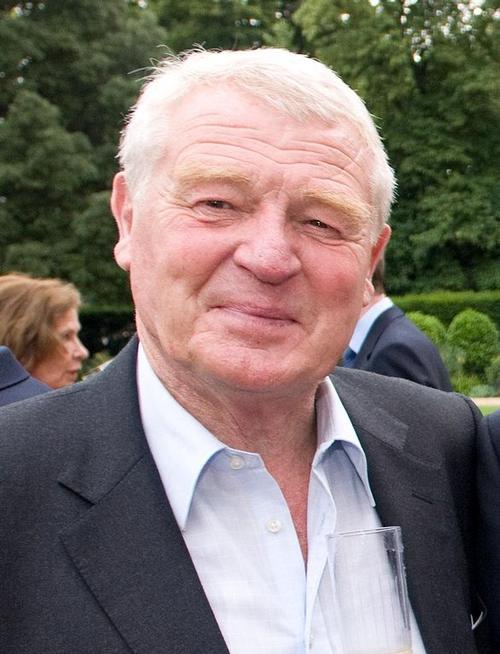
Then UN High Representative Paddy Ashdown interpreted the result not as a return to "old" nationalism, but as a protest against the lack of improvements the previous administration had made. After a difficult cabinet formation, a new government took office in the spring of 2003, in which mainly the three old nationalist parties SDA, HDZ and SDS were in charge.
In December 2004, HV Ashdown was forced to remove from office a number of officials in the RS who did not cooperate sufficiently with the Yugoslavia Tribunal. Collaboration with the tribunal (tracing and arresting war crimes suspects, cooperating with investigations, fighting the criminal networks supporting the suspects) is an international obligation for BiH, which is also strongly emphasized by NATO and the EU. The performance in the RS in this area has improved due to the high international pressure and the sanctions of the HR.
HV Schwarz-Schilling, when he took office in January 2006, indicated that he only wanted to use his "Bonn powers" in very limited cases. The Bosnian authorities must now be given and take responsibility for the various reform processes themselves. Politics in BiH is still mainly conducted on an ethnic basis. Important reforms in the fields of education, public broadcasting and police are therefore experiencing significant delays or even come to a standstill.
Elections in 2006 and 2008 are won by nationalist parties and run along ethnic lines. In July 2008, the people of Sarajevo took to the streets at the news of Karadzic's arrest. In March 2009, Valentin Inzko becomes the new UN High Representative. In February 2010, the Bosnian Serbs passed a law making it easier to hold referendums on national issues. This is seen as a potential opportunity to pave the way for a Bosnian Serb Republic. The 2010 elections do not produce clear winners. In May 2011, the Bosnian Serb Rtako Mladic is arrested in Serbia, he is one of the most wanted war crimes suspects. At the end of 2011, the parties agree to form a new central government. In January 2012, Croatian Vjekoslav Bevanda becomes prime minister.
In May 2012, the trial of Mladic at the Yugoslavia Tribunal starts. In February 2014 there have been riots over protests against corruption and high unemployment. In May 2014, the country was hit by the greatest flood of modern times, with more than half a million people forced to leave their homes. In October, the Party of Democratic Action wins the elections. Denis Zvizdic will become the new Prime Minister in February 2015. In February 2016, Bosnia and Herzegovina officially applies to join the EU. In March 2016, the former leader Karadcic was found guilty by the UN Tribunal in The Hague of genocide and war crimes and sentenced to 40 years in prison. In November 2017, after a lengthy trial, Mladic was found guilty of genocide and crimes against humanity and sentenced to life.
Bosnia and Herzogevina has a three member presidency (1 Bosniak and 1 Croat elected from the Federation of Bosnia and Herzegovina and 1 Serb elected from the Republika Srpska) directly elected by simple majority popular vote for a 4-year term (eligible for a second term, but then ineligible for 4 years); the presidency chairpersonship rotates every 8 months with the new member of the presidency elected with the highest number of votes starting the new mandate as chair; election last held on 7 October 2018
The presidents are Zeljko KOMSIC (chairman since 20 July 2021; presidency member since 20 November 2018 - Croat seat); Sefik DZAFEROVIC (presidency member since 20 November 2018 - Bosniak seat); Milorad DODIK (presidency member since 20 November 2018 - Serb seat). Next elections are to be held in October 2022.
Sources
Campschreur, W. / Bosnië-Herzegovina : mensen, politiek, economie, cultuur, milieu
Koninklijk Instituut voor de Tropen : Novib
Gabrielpillai, M. / Bosnia and Herzegovina
Gareth Stevens Publishing
Milivojevic, J. / Bosnia and Herzegovina
Children’s Press
Phillips, D. / Bosnia and Herzegovina
Chelsea House Publishers
CIA - World Factbook
BBC - Country Profiles
Copyright: Team The World of Info